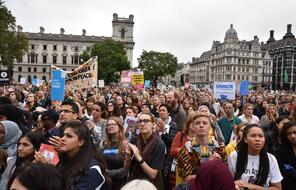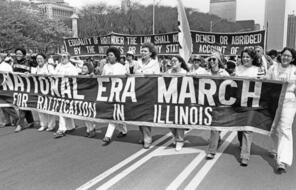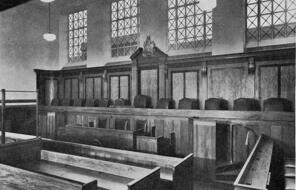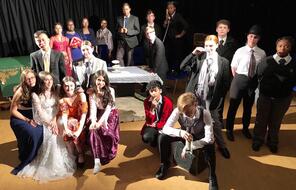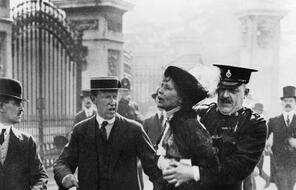Taking Down the Confederate Flag
At a Glance
Language
English — USSubject
- Civics & Citizenship
- Democracy & Civic Engagement
- Human & Civil Rights
The stories we tell about the past can have a profound effect on the present. Our choices about how to remember the past and how we use historical symbols can divide communities and also draw them together. In this way, our relationship to the past has the power to transform our present and our future.
In 2015, the decades-long debate over a symbol from the American past intensified. On June 17, 2015, a 21-year-old white man shot and killed nine African American worshippers in the Emanuel African Methodist Episcopal Church in Charleston, South Carolina. The gunman said that he hoped the shooting would ignite a race war in the United States. Investigators later found that the shooter had detailed his racist beliefs on the Internet and posted photos of himself with the Confederate flag.
These photos ignited debate across the United States about the meaning and power of historical symbols. In the United States, the Confederate battle flag from the Civil War has long been a divisive symbol of the country’s history. Most historians maintain that the central issue of the Civil War, which was fought in the 1860s, was slavery; the Confederate states separated from the rest of the country because their leaders believed that the federal government would soon abolish slavery throughout the nation. Yet many Americans today continue to feel an affinity for the battle flag of the Confederate army, the forces that fought to defend the practice of slavery.
Why? Some Americans continue to identify with the beliefs of white supremacy that justified slavery and segregation. Others hold different beliefs about the meaning of the flag. For instance, according to one slogan popular among the flag’s supporters, the flag stands for “heritage, not hate.” They believe that it honors their ancestors who fought in the Civil War, and that it is a symbol of pride in their distinctive region of the country and its culture. Many of those who take pride in the Confederate flag also believe that their ancestors were motivated primarily by the principle that individual states have the right to govern themselves and be left alone by the federal government. Therefore, they believe that the flag represents freedom from excessive government, not racism and oppression. Until 2015, a handful of former Confederate states flew the Confederate battle flag alongside the American flag atop or near their capitol buildings.
Many other Americans think the Confederate flag is offensive. They believe that the flag is a symbol of hate and oppression because it was the flag flown by those who fought to preserve the enslavement of millions of black Americans. Those who believe the flag is a symbol of hate also point to the fact that it was rarely flown from the end of the Civil War until the 1950s. After that point, some white Americans and southern state governments began to fly the flag in protest of the campaign during the civil rights movement to end segregation.
After the 2015 shootings in Charleston, debate over the flag intensified. Some Americans rallied in support of this symbol from the past. Others stepped up their protests. On June 27, 2015, African American activist Bree Newsome climbed the 30 foot flagpole in front of the South Carolina state house and removed the Confederate flag. She was later arrested and the flag returned. In a statement, Newsome wrote:
I realized that now is the time for true courage the morning after the Charleston Massacre shook me to the core of my being. I couldn’t sleep. I sat awake in the dead of night. All the ghosts of the past seemed to be rising.
A white man had just entered a black church and massacred people as they prayed. He had assassinated a civil rights leader. This was not a page in a textbook I was reading nor an inscription on a monument I was visiting. 1
As the debate continued, some Americans changed their minds about the flag. On the same day Newsome climbed the flagpole, Josh Clark, a young white man from Tennessee, posted the following on his Facebook page:
It’s no big secret to my friends that I love to hunt, fish, camp and do pretty much anything outdoors. I have always considered myself to be a country boy stuck in the city. One of the ways that I used to show pride for my lifestyle was wearing t-shirts with the Confederate/Rebel flag on them. In high school, I even had a bumper sticker on my truck that read “Keep It Flying”. I had grown up seeing the flag regularly, and although I had seen it used in negative ways on occasion, I chose to accept the “Heritage not Hate” and “Pride not Prejudice” interpretation of the flag. If you had asked me back then, I would’ve told you that it was a symbol of southern pride and had nothing to do with racism.
I was raised pretty close to downtown Nashville and grew up with kids of all races with all kinds of backgrounds. I played baseball, basketball and football on teams where sometimes whites were minorities. I am very thankful for this. As I continue to grow and learn, I realize that we tend to fear things just because we don’t understand them. Because of where and how I was raised, I never feared people of other color or background. I was able to realize that we are all the same underneath. I have had white friends, black friends, Asian friends, Middle Eastern friends, Latino friends, Christian friends, Muslim friends, Atheist friends, etc. Thankfully, I have never had a racist bone in my body.
It wasn’t until well into my college years when I began to start thinking for myself. I no longer let the people I was raised by tell me how to view every issue and tried my best to be more open-minded. I believe that one of the most important things for us to do as humans is to try putting ourselves in others’ shoes before we make any kind of judgment.
Although I never meant anything racist by sporting the Confederate flag, I couldn’t help but think of what some of my black friends thought about it. I really can’t think of a time that I was confronted about it. Did it not offend them? Were they too nice or afraid to confront me about it? The more I researched about the history of the flag, the worse I felt. What I had been told about its history was wrong. Thousands of southerners still fly the flag with no racist intent. They still defend the good things they’ve been told about the flag. They, like I once was, are WRONG. The flag is a symbol of a way of life that was wrong. Not that it needs to be stated, but slavery is one of the most evil and cruel things this world has ever seen. The Confederate flag represents this evil. Where is the pride in that? The Confederate flag is also a sign of division. How can you truly be a patriot of this country and fly this flag? Do we really need to fly a flag to show that we are southern, or that we like to hunt and fish, especially when it’s offensive to so many? It is not a kind thing, a good thing, or the right thing to do.
To those against removing the flag, I do not think you are a bad person. I know what it once meant to me. I do, however, challenge you to do your research. Step outside of what your family taught you and be open-minded. Even if you believe in a different history lesson, is flying a flag worth the pain it causes others? Please try to view these issues from the other side of the argument.
To those I may have offended in the past, who never confronted me, I apologize. I was WRONG.
As our country continues to move forward on equality issues, I believe the only place for the Confederate flag is in our history books. 2
In the weeks that followed the Charleston shooting, the South Carolina legislature engaged in several days of debate over whether or not to remove the Confederate battle flag from the grounds of the state capitol building. Jenny Horne—a state representative who is descended from the president of the Confederacy, Jefferson Davis—is credited by many with turning the tide of the debate toward taking down the flag. She did so with an appeal to community:
I have heard enough about heritage. I have a heritage: I am a lifelong South Carolinian. I am a descendant of Jefferson Davis. . . . But that does not matter. It’s not about Jenny Horne. It’s about the people of South Carolina who have demanded that this symbol of hate come off of the Statehouse grounds. 3
State Senator Paul Thurmond also looked past his ancestry and appealed to the value of community. Thurmond’s father was a United States senator and former South Carolina governor who led the opposition to civil rights in the 1940s, 1950s, and 1960s. During the 2015 debate over the flag, Paul Thurmond argued:
I think the time is right and the ground is fertile for us to make progress as a state and to come together and remove the Confederate battle flag from prominent statue outside the Statehouse and put it in the museum. It is time to acknowledge our past, atone for our sins and work towards a better future. That future must be built on symbols of peace, love, and unity. That future cannot be built on symbols of war, hate, and divisiveness.
I am aware of my heritage. But my appreciation for the things that my forebearers [sic] accomplished to make my life better doesn’t mean that I must believe that they always made the right decisions and, for the life of me, I will never understand how anyone could fight a civil war based, in part, on the desire to continue the practice of slavery . . .
I have often wondered what is my purpose here, in the Senate. I’ve asked God to guide me and strengthen me. I have prayed that I will be able to make a difference for this state. I have prayed that I will leave this place better for the future generations. I am proud to take a stand and no longer be silent. I am proud to be on the right side of history regarding the removal of this symbol of racism and bigotry from the statehouse. But let it not satisfy us to stop there. Justice by halves is not justice. We must take down the confederate flag, and we must take it down now. But if we stop there, we have cheated ourselves out of an opportunity to start a different conversation about healing in our state. I am ready. Let us start the conversation. 4
The South Carolina legislature voted to remove the Confederate flag from the grounds of its capitol building. The flag was taken down on July 10, 2015.
Connection Questions
- Why did the murders at the Emanuel African Methodist Episcopal Church prompt debate about the Confederate flag? Was removing the flag from the South Carolina statehouse a necessary response to the killings? Was it sufficient?
- What do you think Bree Newsome meant by “the ghosts of the past”? What were the ghosts that she is referring to? Why did they inspire such a dramatic act? In what other ways can we respond to echoes of violence and injustice from the past?
- What changed Josh Clark’s mind about the Confederate flag? Why do you think he wrote about it on Facebook? What does Clark’s Facebook post suggest about the qualities citizens need in order to live together in a diverse democracy?
- How should a society determine which symbols and people from history should be honored in public spaces, like parks and government buildings, and which should be rejected?
- In a democracy, should an offensive symbol be allowed to remain in a public space even if everyone does not find it offensive?
- 1Goldie Taylor, "Bree Newsome Speaks For The First Time After Courageous Act of Civil Disobedience," Blue Nation Review, last modified June 29, 2015, accessed August 21, 2017.
- 2Josh Clark, Facebook update (public post), June 27, 2015.
- 3Quoted in Bill Chappell, "Watch: Confederate Descendant's Scathing Address In S.C. Flag Debate," The Two-Way, NPR, last modified July 9, 2015, accessed July 13, 2016.
- 4Quoted in Edwin Rios, "Strom Thurmond's Son Just Called for the Removal of the Confederate Flag," Mother Jones, last modified June 24, 2015, accessed July 13, 2016.
How to Cite This Reading
Facing History & Ourselves, "Taking Down the Confederate Flag," last updated March 14, 2016.
This reading contains text not authored by Facing History & Ourselves. See footnotes for source information.

